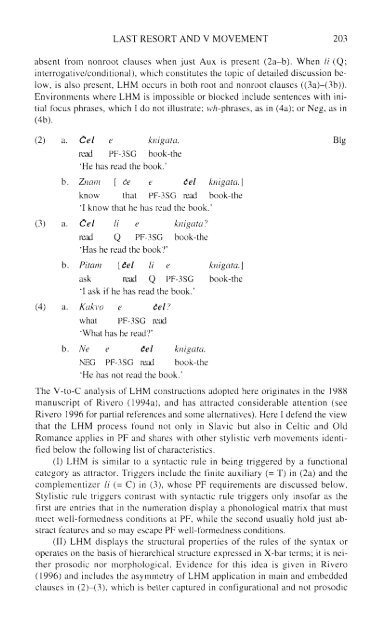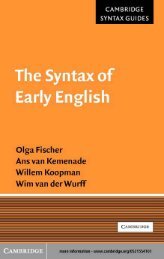Comparative Syntax of the Balkan Languages (Oxford ... - Cryptm.org
Comparative Syntax of the Balkan Languages (Oxford ... - Cryptm.org
Comparative Syntax of the Balkan Languages (Oxford ... - Cryptm.org
- No tags were found...
You also want an ePaper? Increase the reach of your titles
YUMPU automatically turns print PDFs into web optimized ePapers that Google loves.
LAST RESORT AND V MOVEMENT 203absent from nonroot clauses when just Aux is present (2a-b). When li (Q;interrogative/conditional), which constitutes <strong>the</strong> topic <strong>of</strong> detailed discussion below,is also present, LHM occurs in both root and nonroot clauses ((3a)-(3b)).Environments where LHM is impossible or blocked include sentences with initialfocus phrases, which I do not illustrate; wh-phrases, as in (4a); or Neg, as in(4b).(2)(3)(4)a. Cel e knigata.read PF-3SG book-<strong>the</strong>'He has read <strong>the</strong> book.'b. Znani [ ce e del knigata. ]know that PF-3SG read book-<strong>the</strong>'I know that he has read <strong>the</strong> book.'a. Cel li e knigata?read Q PF-3SG book-<strong>the</strong>'Has he read <strong>the</strong> book?'b. Pit am [del It e knigata.]ask read Q PF-3SG book-<strong>the</strong>'I ask if he has read <strong>the</strong> book.'a. Kakvo e del?what PF-3SG read'What has he read?'b. Ne e del knigata.NEG PF-3SG read book-<strong>the</strong>"He has not read <strong>the</strong> book.'The V-to-C analysis <strong>of</strong> LHM constructions adopted here originates in <strong>the</strong> 1988manuscript <strong>of</strong> Rivero (1994a), and has attracted considerable attention (seeRivero 1996 for partial references and some alternatives). Here I defend <strong>the</strong> viewthat <strong>the</strong> LHM process found not only in Slavic but also in Celtic and OldRomance applies in PF and shares with o<strong>the</strong>r stylistic verb movements identifiedbelow <strong>the</strong> following list <strong>of</strong> characteristics.(I) LHM is similar to a syntactic rule in being triggered by a functionalcategory as attractor. Triggers include <strong>the</strong> finite auxiliary (= T) in (2a) and <strong>the</strong>complementizer li (= C) in (3), whose PF requirements are discussed below.Stylistic rule triggers contrast with syntactic rule triggers only ins<strong>of</strong>ar as <strong>the</strong>first are entries that in <strong>the</strong> numeration display a phonological matrix that mustmeet well-formedness conditions at PF, while <strong>the</strong> second usually hold just abstractfeatures and so may escape PF well-formedness conditions.(II) LHM displays <strong>the</strong> structural properties <strong>of</strong> <strong>the</strong> rules <strong>of</strong> <strong>the</strong> syntax oroperates on <strong>the</strong> basis <strong>of</strong> hierarchical structure expressed in X-bar terms; it is nei<strong>the</strong>rprosodic nor morphological. Evidence for this idea is given in Rivero(1996) and includes <strong>the</strong> asymmetry <strong>of</strong> LHM application in main and embeddedclauses in (2)-(3), which is better captured in configurational and not prosodicBlg
















